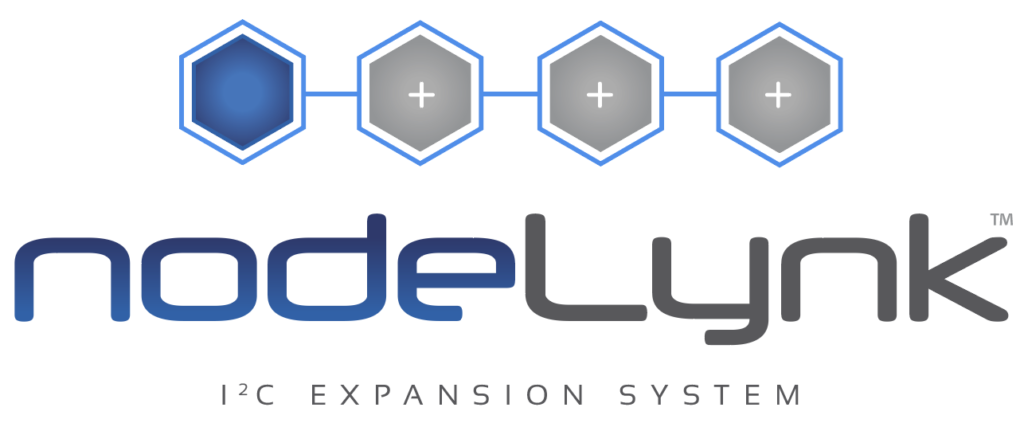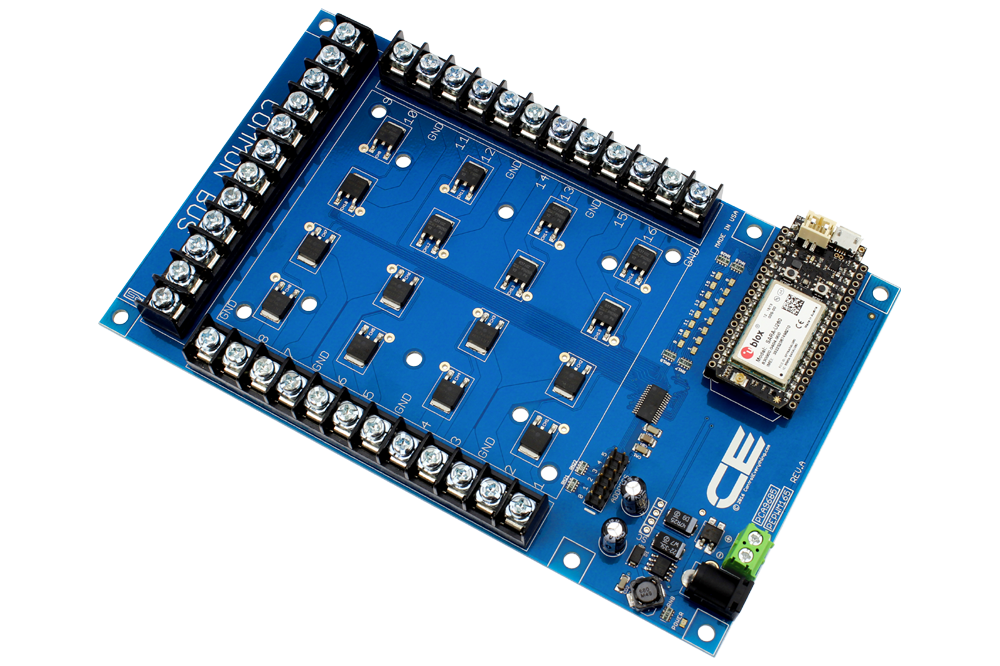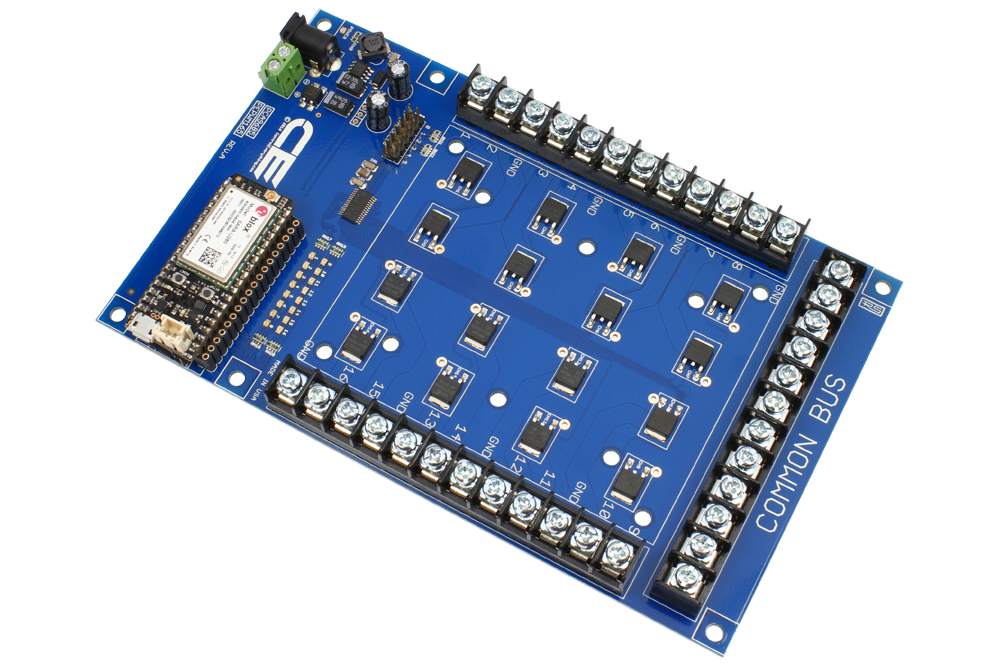PCA9685 16-Channel 12-Bit 5-Amp High-Current N-Channel PWM Pulse Width Modulation Light Dimmer with IoT Interface
Highlights
- For LED or Incandescent Light Dimming
- High Resolution 12-Bit Light Dimming
- 4096 Brightness Levels per Channel
- 16-Channels of Light Dimming
- 5-Amps per Channel at 100VDC
- N-Channel Open Collector Outputs
- Directly Compatible with Photon, Electron, and Bluz
- Adaptable to Arduino, Raspberry Pi, BeagleBone, Onion and More
- Expandable to Control Over 900 Channels
- I2C Expansion Port with I2C Cable Included
DC LED and Incandescent Light Dimming is easier than ever using your favorite IoT communications platform.
Equipped with our IoT interface, plug-in your favorite IoT communication module and develop firmware control lights from anywhere in the world! The NCD IoT interface support Particle Electron for cellular access. Use the Particle Photon to control this device over WiFi. The IoT interface also supports Bluz (Bluetooth BLE) or you can use one of our adapters to plug in Arduino Nano, Arduino Micro, USB, PyCom WyPy, directly on-board! Plug in the SI I2C adapter for interface to Raspberry Pi, BeagleBone, or Arduino Uno. The NCD IoT interface standard makes it easy to connect to just about any computer or microcontroller!
Based on our plug-and-play I2C interface standard, all NCD IoT devices support I2C communications using a I2C expansion port, making it easy to expand to a wide variety of sensors, relay controllers, PWM controllers, and much more!
This controller consists of a PCA9685 16-Channel I2C 12-Bit PWM controller connected to 16 high-current N-Channel FETs. The PCA9685 support 62 devices per I2C port, allowing you to control up to 992 channels over a cellular cloud connection. This controller is configured as a “Low-Side” driver.
Operation is very easy, simply connect an external light to a power supply up to 100VDC and feed the ground of the light through this controller. This controller will switch the ground on and off at high-speed, causing a light dimming effect with 4096 brightness levels per channel.
This controller only uses the I2C SCL and SDA lines of the Particle Electron, leaving all other I/O pins available for other applications. Our GitHub repository (ControlEverythingCom) contains a complete library ready to use with your Particle Electron, Photon, or Bluz, eliminating the need to write code to control this device.
This light dimmer is also compatible with a 418MHz Key Fob receiver (Part Number: PKFR sold separately), allowing your Particle Electron to receive and process remote Key Fob commands up to 750 feet away. Up to 40 remote controls may be associated to the PKFR. Program your Particle Electron to control relays in any way you can imagine through the use of a remote Key Fob. Compatible with 1, 2, 3, 4, 5, and 8-Button MS Series Key Fobs from Linx Technologies.
NOTE: This controller requires a 12VDC Power Supply for proper operation. A separate power supply is recommended for external incandescent or high-power LED lights. This controller is capable of switching 100VDC at 5 Amps, and is able to switch considerably more current at lower voltages. Experimentation is recommended at lower voltages, we suggest a FET operating temperature of 125º Fahrenheit or less. Integrated I2C Expansion port makes this device fully compliant with our complete line of I2C devices, allowing you to combine sensors, relay controllers, more light dimmers, and many other types of devices to a single IoT communications module.
What is the NCD IoT Interface?
The NCD IoT Interface provides users with a means of changing or upgrading the IoT communications technology as new technologies emerge. The NCD IoT Interface is directly compatible with Particle Photon for WiFi communications, Electron for Cellular Communications, Bluz for Bluetooth. Optionally, adapters may be installed to provide a direct interface to Arduino Nano, Micro, USB, PyCom WyPy, Onion Omega, Raspberry Pi, and much more. The NCD IoT interface allows you to re-use your hardware so it never becomes obsolete! Based on I2C communications, the NCD IoT Interface uses only 2 GPIO lines of your microcontroller, freeing the rest of your CPU for other tasks.
nodeLynk™ IoT Device Expansion
This is a IoT Device which accepts a common processor and provides on-board sensing or control capabilities. This IoT device may be expanded to include additional hardware functionality using nodeLynk Expansion Devices. The NCD IoT socket found on IoT devices is capable of directly handling NCD ESP8266 and ESP32 series processors as well as Particle Photon and Particle Electron. We also manufacture many adapters for the NCD IoT socket for Arduino Nano, Micro, and Feather microprocessor modules. Between the socket is a nodeLynk connector, which is used for I2C Expansion.


What is nodeLynk?
Chain expansion devices using nodeLynk. Connect a wide variety of accessories to expand the capabilities of a nodeLynk compatible controller. Use nodeLynk to add Relay Controllers, Sensors, PWM Drivers, Displays, and a wide variety of 4-20mA, 0-10V ADCs and DACs, as well as a wide array of TTL & Isolated GPIO devices. All nodeLynk devices use I2C communications to chain devices together. nodeLynk is an easy way to expand functionality without soldering. nodeLynk allows expansion in seconds so you can focus on your software and firmware development.

Unlimited I2C Expansion
Based on our plug-and-play nodeLynk I2C interface standard, all NCD IoT devices are equipped with a nodeLynk I2C expansion port, making it easy to expand to a wide variety of sensors, current monitors, relay controllers, PWM controllers, and much more! We are always designing new nodeLynk expansions for our plug-and-play nodeLynk I2C framework. We are dedicated to building a product line of interconnected devices to simplify all forms of automation. Re-use or upgrade your hardware in seconds by selecting the modules that best fit your needs, and chaining them together using the included nodeLynk I2C expansion cables!
Mechanical Drawing
Wiring Diagrams
Documentation
Datasheets
Documentation Downloads
Official Repository
IoT Interface Compatibility
NCD IoT Interface devices are designed to plug in to many popular IoT computing platforms. This allows the “brains” from other manufacturers to directly plug into our devices for easy plug-and-play operation. IoT interface devices use I²C as the underlying communications technology. The notes below will guide you into plugging 3rd party IoT technologies into our devices, we will highlight any adapters that may be required in this section. Please note that all IoT Interface Devices act as a I²C Master Device, and may be expanded by connecting to any of our Cross-Platform nodeLynk I²C Slave Devices using the nodeLynk I²C Output.
NCD IoT Interface Direct Connection
The following devices directly plug into NCD IoT Interface controllers without a adapter.
- Particle Electron
- Particle Photon (Particle.io)
- Bluz Module (Bluz.io)
- ESP8266 Module
If using a Particle Photon or Particle Electron communications module, the PKFR Key Fob Receiver overlay shield may be used to add long-range wireless Key Fob remote control to the communications module.
NCD IoT Interface Adapters
Use the following adapters will adapt the IoT Interface for I2C communications with other popular computing platforms:
- Arduino Nano using the Arduino Nano Adapter
- Arduino Micro using the Arduino Micro Adapter
- Onion Omega 1&2 using the OC Adapter
- Pycom WiPy using the WiPy Adapter
- Pycom WiPy2 & LoPy using LoPy Adapter
- Adafruit Huzzah ESP8266 using the Adafruit Huzzah Adapter
- Windows using USB Interface and the USB IoT Interface Adapter
Convert IoT to I2C Interface Devices
- This device may be converted to an I²C slave device using the I2C to IoT Interface Adapter, ideal for use with Raspberry Pi, Beaglebone, Arduino Uno, and BridgeX5.
Arduino Interface
- Use the I2C to IoT Interface Adapter and a Arduino Uno Interface Adapter
- Use the I2C to IoT Interface Adapter and a Arduino Nano I²C Shield
- Use the I2C to IoT Interface Adapter and plug into any Arduino Nano Master Device
- Use the I2C to IoT Interface Adapter and plug into any Arduino Micro Master Device
- Use the I2C to IoT Interface Adapter and plug into any Arduino Due Master Device
BeagleBone Interface
- Use the I2C to IoT Interface Adapter and a BeagleBone I²C Interface Adapter
Banana Pi Interface
- Use the I2C to IoT Interface Adapter and a Banana Pi I²C Interface Adapter
C.H.I.P. Interface
- Use the I2C to IoT Interface Adapter and a C.H.I.P. I²C Interface Adapter
Raspberry Pi Interface
- Use the I2C to IoT Interface Adapter and a Raspberry Pi I²C Interface Adapter
- Use the I2C to IoT Interface Adapter and a Raspberry Pi 2/3 I²C Interface Adapter
- Use the I2C to IoT Interface Adapter and a Raspberry Pi Zero I²C Interface Adapter
Windows 8/10 PC Interface
- Use the I2C to IoT Interface Adapter and a USB to I2C Converter
- Use the I2C to IoT Interface Adapter and a BridgeX5 Series Controller
Key Fob Compatibility
NCD IoT Interface devices are also compatible with a 418MHz Key Fob receiver (Part Number: PKFR), allowing your Particle Electron, Photon, or Bluz to receive and process remote Key Fob commands up to 750 feet away. Up to 40 remote controls may be associated to the PKFR. Program your IoT communications module to receive wireless remote control commands using a Key Fob. Compatible with 1, 2, 3, 4, 5, and 8-Button MS Series Key Fobs from Linx Technologies.
Out of stock



